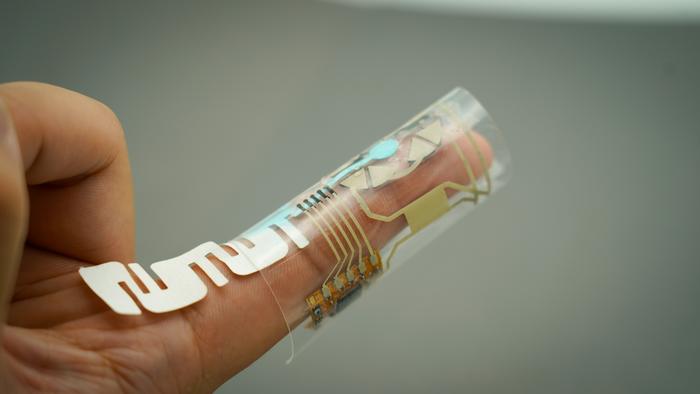A sweat-powered wearable has the potential to make continuous, personalized health monitoring as effortless as wearing a Band-Aid. Engineers at the University of California San Diego have developed an electronic finger wrap that monitors vital chemical levels—such as glucose, vitamins, and even drugs—present in the same fingertip sweat from which it derives its energy.
A sweat-powered wearable has the potential to make continuous, personalized health monitoring as effortless as wearing a Band-Aid. Engineers at the University of California San Diego have developed an electronic finger wrap that monitors vital chemical levels—such as glucose, vitamins, and even drugs—present in the same fingertip sweat from which it derives its energy.
The advance was published Sept. 3 in Nature Electronics by the research group of Joseph Wang, a professor in the Aiiso Yufeng Li Family Department of Chemical and Nano Engineering at UC San Diego.
The device, which wraps snugly around the finger, draws power from an unlikely source—the fingertip’s sweat. Fingertips, despite their small size, are among the body’s most prolific sweat producers, each packed with over a thousand sweat glands. These glands can produce 100 to 1000 times more sweat than most other areas of the body, even during rest. This constant trickle of natural perspiration—without any stimuli or physical activity—offers a reliable energy source, fueling the device even during periods of inactivity or sleep.
The device is constructed from several electronic components printed onto a thin, flexible and stretchable polymer material. Its design allows it to conform to the finger while being durable enough to withstand repeated bending, stretching and movement. “It is based on a remarkable integration of energy harvesting and storage components, with multiple biosensors in a fluidic microchannel, along with the corresponding electronic controller, all at the fingertip,” said Wang.
“This is automatic health monitoring at your fingertips,” said study co-first author Shichao Ding, a postdoctoral researcher in Wang’s research group at the UC San Diego Jacobs School of Engineering. “The wearer can be resting or asleep, and the device can still harvest energy and track biomarker levels.”
In tests, a subject wore the device throughout the day to track glucose levels during meals, lactate levels during both desk work and exercise, vitamin C levels while drinking orange juice, and levodopa levels after eating fava beans, a natural source of the compound.
Ding and co-first author Tamoghna Saha say that the device can be customized to cater to individual health needs by detecting different sets of biomarkers. The researchers are working on developing a closed-loop system that not only monitors biomarkers, but also administers treatments based on the collected data. For instance, in the case of diabetes, such a device could continuously monitor glucose levels and automatically deliver insulin as needed, then assess the treatment’s effectiveness by further monitoring biomarker levels.
“Autonomous power, sensing and treatment all in one device—that’s the ultimate goal,” said Ding.
Journal
Nature Electronics
DOI
10.1038/s41928-024-01236-7
Article Title
A fingertip wearable microgrid system for autonomous energy management and metabolic monitoring
Article Publication Date
3-Sep-2024





